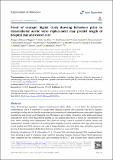Proof of concept: digital clock drawing behaviors prior to transcatheter aortic valve replacement may predict length of hospital stay and cost of care
Author(s)
Wiggins, Margaret Ellenora; Dion, Catherine; Formanski, Erin Formanski; Davoudi, Anis Davoud; Amini, Shawna; Heilman, Kenneth M; Penney, Dana; Davis, Randall; Garvan, Cynthia W; Arnaoutakis, George J; Tighe, Patrick; Libon, David J; Price, Catherine C; ... Show more Show less
DownloadPublished version (1.557Mb)
Publisher with Creative Commons License
Publisher with Creative Commons License
Creative Commons Attribution
Terms of use
Metadata
Show full item recordAbstract
<jats:p>Aims: Reduced pre-operative cognitive functioning in older adults is a risk factor for postoperative complications, but it is unknown if preoperative digitally-acquired clock drawing test (CDT) cognitive screening variables, which allow for more nuanced examination of patient performance, may predict lengthier hospital stay and greater cost of hospital care. This issue is particularly relevant for older adults undergoing transcatheter aortic valve replacement (TAVR), as this surgical procedure is chosen for intermediate-risk older adults needing aortic replacement. This proof of concept research explored if specific latency and graphomotor variables indicative of planning from digitally-acquired command and copy clock drawing would predict post-TAVR duration and cost of hospitalization, over and above age, education, American Society of Anesthesiologists (ASA) physical status classification score, and frailty.
Methods: Form January 2018 to December 2019, 162 out of 190 individuals electing TAVR completed digital clock drawing as part of a hospital wide cognitive screening program. Separate hierarchical regressions were computed for the command and copy conditions of the CDT and assessed how a-priori selected clock drawing metrics (total time to completion, ideal digit placement difference, and hour hand distance from center; included within the same block) incrementally predicted outcome, as measured by R2 change significance values.
Results: Above and beyond age, education, ASA physical status classification score, and frailty, only digitally-acquired CDT copy performance explained significant variance for length of hospital stay (9.5%) and cost of care (8.9%).
Conclusions: Digital variables from clock copy condition provided predictive value over common demographic and comorbidity variables. We hypothesize this is due to the sensitivity of the copy condition to executive dysfunction, as has been shown in previous studies for subtypes of cognitive impairment. Individuals undergoing TAVR procedures are often frail and executively compromised due to their cerebrovascular disease. We encourage additional research on the value of digitally-acquired clock drawing within different surgery types. Type of cognitive impairment and the value of digitally-acquired CDT command and copy parameters in other surgeries remain unknown.</jats:p>
Date issued
2021Department
Massachusetts Institute of Technology. Department of Electrical Engineering and Computer ScienceJournal
Exploration of Medicine
Publisher
Open Exploration Publishing
Citation
Wiggins, Margaret Ellenora, Dion, Catherine, Formanski, Erin Formanski, Davoudi, Anis Davoud, Amini, Shawna et al. 2021. "Proof of concept: digital clock drawing behaviors prior to transcatheter aortic valve replacement may predict length of hospital stay and cost of care." Exploration of Medicine, 2.
Version: Final published version